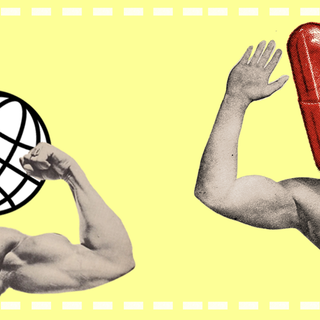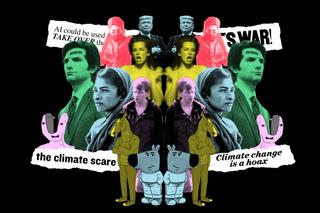
The Year of Nihilism
When things reach a certain threshold of absurdity, meaning breaks down, and the great nihilistic awakening has brought recognition of the fact that we’re not meant to feel like any of this is normal.

The general consensus is that everything’s fucked. The common counter is: well, at least it’s not as bad as before. The counter to that: actually, the world is worse than it has ever been. Pop intellectuals like Stephen Pinker disagree with that based on true statistics – like the fact that we have better healthcare than ever, the average human’s life expectancy is much higher, there are fewer famines and diseases, there is no major world war in the offing (yet). So why does it all feel so bleak, pointless, and numbing?
The short answer: there are more people than ever who have less access than ever to all the advancements we’ve made as a society. This leads to a crisis of overconsumption coexisting with terrible statistics on every metric of human security, which does something strange to the brain and to the culture. Oxfam reports keep showing greater and greater wealth in the hands of fewer and fewer people, while hunger indices routinely rank India at the bottom. Superpowers actively sponsor genocides while broadcasting their local football games to the world and McKinsey reports compile data on girls’ education while consulting on the PR-cleanup of the families responsible for journalists’ murders and opioid epidemics. So many incongruent things happen simultaneously for everyone to see all at once, it beggars belief that anybody is even sane.
Maybe nobody is. When things reach a certain threshold of absurdity, meaning breaks down, and the great nihilistic awakening has brought recognition of the fact that we’re not meant to feel like any of this is normal.
The nihilistic turn in culture has been on the horizon for some time. In the mid 2010s, Black Mirror captivated an audience that still thought the technocalypse was a little ways away and that each hopeless, existentially terrifying episode was but a cautionary tale. But we already have AI grief-bots and a social credit system, to only name a few of the show’s predictions that came true in recent years. Then, a little cartoon horse prompted endless video essays and lectures on the philosophy of nihilism: Bojack Horseman. It wasn’t even the 2020s yet, but the seeds of a civilizational collapse were clearly evident, in the form of an irredeemable character whom you cannot morally root for – Bojack went on destructive, drug-fuelled benders and became complicit in the abuse and death of his co-star – and it’s all because of his shitty childhood trauma. The “moral” of the story is that there isn’t one: the hand you’re dealt isn’t an excuse for anything.
Immediately after the pandemic, nihilism came to us at the workplace in the form of Severance – a bleak show about bleak lives in bleak offices. Last year, Succession’s last season featured the most cynical episode of television in years, when it showed American democracy placed in the hands of self-interested media titans who are bedfellows with an actual fascist. These were some of the last decade’s greatest hits, and they implicated the self, the workplace, our commodities, and society itself. Almost all the warnings about the kind of society to come had been represented in art. Now, there is truly nothing left to say. Of the top 10 highest grossing films worldwide this year, for example, 8 were either sequels or franchises. Dune: Part Two. Gladiator II. Inside Out 2. Moana 2. Deadpool and Wolverine. Wicked. All reboots of some form or another. In the domestic box office, the story is no different: Stree 2, Bhool Bhulaiyya 3, Pushpa 2, Singham Again were the year’s biggest hits with the biggest budgets. Have we run out of new stories, or the will to tell them?
The definition of insanity is to do the same thing again, expecting something different each time. If movies are what we want, a sequel is what we shall get. If music is what we want, an old track (or a remixed version of it) bumped back on the Billboard charts is what we shall have. If offline experiences are what we crave, lookalike contests are our fix. The resultant image is eerily similar to child’s play: following the same scripts with the same toys again and again, until we’re in a collective trance. It is in this trance-like dream state that we also consume live-action genocide in one part of the world, before scrolling past to a “Diet Pepsi” reels dance, or twenty or a hundred of them, given there are entire accounts dedicated to posting the same dance or the same meme every single day.
When media isn’t in the form of sequels of 15-second videos, it’s in the form of bad AI. The reigning criticism of AI-generated content is that it’s theft. But the real problem is that it’s ugly – aesthetically, ethically, and politically. In the run-up to the U.S. Presidential elections, a social media user generated AI-images imagining what the same political race would look like in India. Some anthropomorphic meme animals like Pepe the Frog and Doge turned into alt-right political symbols (thanks to White supremacists and Elon Musk who made them their mascots), others like the “Chill Guy” dog are just presented without comment in the middle of chaos. The AI-esque uncanny valley effect has pervaded the news too: legacy news-run Instagram pages using AI stock images, juxtaposed with painfully earnest headlines like “[Celebrity] says [basic thing about mental health/feminism/body image], Netizens react.” There’s nothing to talk about, nothing to respond to. Elon Musk is seemingly the most active account on his own platform, in perpetual conversation with himself and his lackeys who all love his Cybertruck, built in the exact mold of Musk’s own megalomania.
Meanwhile, “brainrot” is the Oxford dictionary’s word of the year – speaking directly to the uroboric cultural awareness that we’re all wasting our time and our lives away. Generation Alpha speaks a language few can understand; those who do learn about it are disconcerted to find out that “mewing” and “sigma” are terms borrowed from incel culture. Speaking of which, incels just spent a month running amok in random women’s social media mentions saying things like “your body my choice” after Donald Trump, TIME’s person of the year for the second time, was re-elected as the American President. Another sizable demographic, some of which overlaps with Trump’s, just went after a Cambridge doctoral student for posting about her PhD on the politics of smell and cited the word “olfactory” as a reason for the humanities not to exist. The trifecta of cultural anhedonia – brats, boors, brainrot galactica – has one thing in common, and it’s the nihilistic impulse to eschew meaning completely.
In real life, cities are getting more polluted, and climate change isn’t just at our doorstep but actually on the threshold. This year, the city of New Delhi saw an air quality index number that looks extremely made up, but wasn’t. Heat, landslides, and floods have become par for the course, but the show must go on. What show, however? Fashion is no longer creating trends, it’s just responding to them. Personal style is dead thanks to a dizzying array of “core” aesthetics. Pantone’s 2025 colour of the year is a dirty smudge that calls itself “mocha mousse.” Quiet luxury is no longer quiet and, hence, redundant. Architecture looks terrible. Mumbai is full of roads with their guts dug up, half-constructed high-rises, and dense smog suspended over the Arabian Sea. Any new building is a mish-mash of brutalist architecture with touches of art deco, with no distinctive current aesthetic to speak of. Any new café is, as Kyle Chayka wrote, the same as every other one. Malls are zombified public spaces; public spaces are zombified private spaces.
Our cultural heroes are all a variation of Nietzsche’s übermensch. There are the fictional ones, like Paul Atreides, who walk a fine line between critiquing and exalting the messiah. There are other fictional ones like Pushparaj, of Pushpa: The Rule fame, whose screen presence is indistinguishable from the actor Allu Arjun’s real-life star power. When Allu Arjun was taken into custody in the case of a fan stampede, he returned to his home on bail within a few hours to a hero’s welcome. The film saw a further spike in ticket sales as a result, in addition to already having broken several box office records despite lukewarm reviews. Classic debates such as substance and form don’t apply here, nor do they have a place. At the movies, only muscle rules. But muscle doesn’t always win. Vinesh Phogat’s Kafkaesque journey from the jaws of defeat, to victory, back to defeat at the Paris Olympics was just another reminder that the universe works on the principle of entropy, and nothing matters. Phogat announced her retirement from wrestling and joined politics. There, at least, she won – but at what cost?
The costs of winning against a system rigged for you to lose are steep, but every once in a while, somebody does step up to pay them. When Luigi Mangione was arrested on suspicion of being the guy who killed the United Healthcare CEO, the Internet threw a Gatsby-esque party of memes, thirst tweets, and jokes. In other words, one of the most joyous occasions online this year only came thanks to a murder in broad daylight and at the tail end of the year. Rich kids have started revolutions before, as many pointed out: from Che Guevara to Fredreich Engels. A single assassination – that of Archduke Ferdinand – was once enough to start a world war. But in 2024, a year in which mass organizing and protests against an ongoing genocide have once again died down to a mere whisper, will this one-off CEO moment spark a revolution – or just memes?
Rohitha Naraharisetty is a Senior Associate Editor at The Swaddle. She writes about the intersection of gender, caste, social movements, and pop culture. She can be found on Instagram at @rohitha_97 or on Twitter at @romimacaronii.
Related


Why Bollywood Never Gets Kashmir Right
